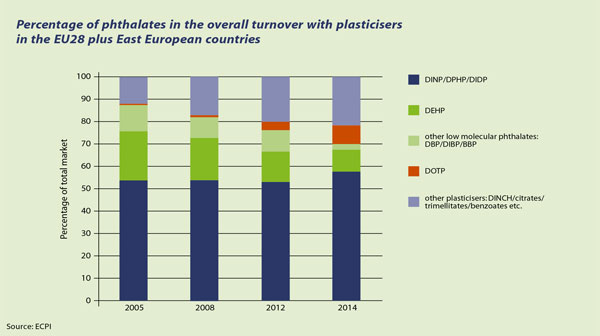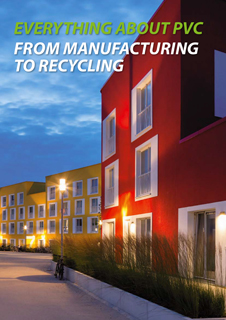Manufacturing and Raw Materials
The European PVC industry has consistently improved its manufacturing processes in recent years. This is especially true for PVC-formulations. Thus, there have been considerable changes in the use of stabilisers and plasticisers.
Synthesis of Crude Oil and Rock Salt
Crude oil/natural gas and rock salt are the starting products for PVC manufacturing. Ethylene is the result of crude oil in the intermediate stage of naphtha through thermal “cracking”. Chlorine, on the other hand, is produced from rock salt through chloralkali electrolysis. For this purpose, the modern energy-saving membrane process is commonly used today. From 2017, this will be the only method used within the EU. Sodium hydroxide and hydrogen are produced as important by-products. In turn, they are the raw materials for many other syntheses. Vinyl chloride (VC) is produced from ethylene and chlorine at a ratio of 43% to 57%. VC is the monomeric building block of PVC. The transformation of VC to PVC takes place through various technological processes to Suspension PVC (S-PVC), Emulsion PVC (E-PVC) and Mass PVC (M-PVC).

Additives
PVC products are derived from a white, odourless powder which is mixed with additives for the further processing of semi-finished and finished products. Such mixtures are not only found in practically all plastics, but also in other materials such as glass, steel, concrete, etc.
Basically, the following additives are used:
- stabilisers and co-stabilisers
- lubricants
- polymer agents to improve impact strength (modifier), heat and form stability, and processing performance
- fillers
- pigments
- plasticisers.
Additives facilitate processing and simultaneously determine the properties of end products. The choice of stabilisers and lubricants depends on processing technologies and requirements of the finished products. Specific material properties of semi-finished and finished products are achieved by the
addition of modifiers, plasticisers and/or pigments. Depending on the choice and quantities of additives, PVC as a raw material can be converted to e. g. extremely thin flexible packaging film (cling film) for fresh meat or robust and thickwalled pipes for potable water. Additives, such as stabilisers and lubricants can be added as individual components or as so called one-pack mixtures. A very wide range of products and properties can be realised by these additives precisely adjusted to the end product performance requirements.
Stabilisers
The use of stabilisers guarantees sufficient heat stability for PVC during processing and protects the end product from change due to heat, UV-light, or oxygen. Especially inorganic and organic salts of the metals calcium, zinc, barium, lead and tin are added to PVC products. These salts are firmly anchored
in the polymer matrix. They are not released during the use of these products. The use of stabilisers has undergone a significant change in recent years. One reason for this was that the European industry discontinued the sale and use of cadmium stabilisers in all EU member states. In addition, the European Stabiliser Producers Association (ESPA) and the European Plastics Converters Association (EuPC) agreed to the voluntary commitment Vinyl 2010 in October 2001 to replace lead stabilisers. Several intermediate goals have therefore been established (basis: consumption in 2000):
- 15% reduction in 2005
- 50% reduction in 2010
- 100% reduction in 2015.
The goal for 2010 was surpassed in 2008. The reduction of lead stabilisers was already at ca. 76% in 2010. At the same time, the research and development of alternative stabiliser systems in recent years has made enormous stride at great financial cost. In addition to systems based on calcium/zinc, whose market share in Western Europe increased from 5% in 1994 to over 50% today, tin also plays an important role. Moreover, new developments utilise metal-free organic stabiliser systems. The amount of thermal stabilisers used in mixtures has been reduced in recent years through more effective additives and optimised processing. Recycled materials might contain cadmium and lead due to the recycling of older products. This is permitted by law in order to create incentives for the use of recycled materials. Directive 494/2011 by the EU Commission from 20 May 2011 regulated
the use of recycled materials containing cadmium.

Plasticisers
Approximately 70% of PVC produced is used in Europe to manufacture rigid products such as window profiles and pipes, which are distinguished by their longevity and weather resistance. The remaining 30% covers soft applications. Plasticisers provide PVC with special properties of use similar to those of rubber. This naturally hard material becomes flexible and elastic through plasticisers. At the same time, it retains its shape. Soft PVC can be applied to a wide range of products in various ways. Pastes made of a mixture of PVC and plasticisers expand the range of possibilities, e.g. by means of expressive vinyl wallcoverings or easy-to-clean flooring.
Soft PVC is distinguished by its outstanding properties of use which offer a versatile range of possibilities. Flexible products such as artificial leather, weather-resistant roofing membranes, or flame-retardant cables enhance our lives and make them safer and more comfortable. In medical care, soft PVC applications have stood the test of time for decades. Blood bags, tube systems, and wound dressings are essential components of patient care. PVC is the most used plastic material in medical applications. PVC products are even recommended for allergy sufferers due to their compatibility.
The most frequently used plasticisers are esters from phthalic acid. In terms of application, a change has taken place on the European market in recent years in favour of high-molecular weight plasticisers. The largest share is made up of DINP and DIDP. These substances have extensively replaced low-molecular weight plasticisers on the market such as DEHP, DBP, and BBP. Special plasticisers have also become important economically in the meantime. These include polymer plasticisers based on adipic acid, adipates, terephthalates, and other phthalatefree plasticisers such as DINCH.

In public discussions, phthalates are repeatedly linked to harmful effects on humans and the environment. These generalisations are not justified. Many phthalates differ from one another considerably in terms of effect. The short-chained phthalates (DBP, DIBP, BBP, DEHP) have been classified as toxic to reproduction, i.e. they are suspected of having an influence on sexual function and fertility. As part of REACH, the new European legislation on chemicals, these phthalates have been listed as „substances of very high concern“. Their production and application were subject to an authorisation process. As a result, these phthalates can still be used in the EU only by companies with the appropriate authorisation since February 2015.
In contrast, the high-molecular weight plasticisers DINP and DIDP have other properties. They are some of the most researched substances in terms of toxicology and ecology. Both plasticisers have undergone EU risk assessments and evaluations for many years. In January 2014, the European Commission published their conclusion for a re-evaluation of measures restricting the placing on the market of toys and childcare articles to be placed in the mouth of children under three years of age. The European Commission agrees with the results of The European Chemical Agency (ECHA), to keep the restrictions for these toys and childcare articles. In contrast, for all other applications there was no risk identified, that further steps to reduce the exposition of DINP and DIDP will be necessary.
Since 1999 the plasticisers DEHP, DBP and BBP are no longer allowed in toys and childcare articles in the EU.

